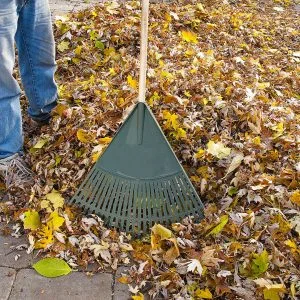We love autumn for the colorful leaves. But those same leaves lead to one of the season’s most unpopular chores: raking. Keeping this colorful carpet on the ground through the winter is not an option if you want a healthy lawn in spring. But if you are one of the many who detest raking, you have a choice. There are benefits to mulching leaves besides just being able to cross raking off of your to-do list.
What Is Mulching Leaves?
Mulching leaves is the process of mowing over them and shredding them to tiny bits. These bits are then left on the lawn to provide it with nourishment, while providing you with a reason not to rake. It’s one method to rid your lawn of fallen leaves and prevent them from forming a thick layer that could smother your turf.
Many professionals and homeowners debate over whether mulching leaves into the turf or raking them to remove them are better for your lawn. But there are pros and cons to each side of the argument. Some studies say that mulched leaves have no effect on grass. Others claim that it can possibly reduce certain weeds.
The Benefits of Mulching Leaves
While the constant twisting and turning of raking puts stress on the body, mulching leaves is simply the same as pushing a mower. It’s often thought of as a quicker and more efficient way to clear away the leaves. In addition, it eliminates the chore of collecting leaves, bagging them, and disposing of them, which may require taking them to a designated area in your municipality. And let’s face it, all of those bags lined up at the edge of the lawn detract from your home’s curb appeal.
The proper amount of mulch left on your lawn feeds the grass, as well as beneficial bugs and earthworms. Over time, the leaves decompose, providing nutrients to strengthen the grass and improve soil. This helps the turf survive the harsh winter and thrive in the spring.
To Mulch or Not to Mulch
Indeed, mulching leaves may be good for your lawn, but it’s a fine line between healthy and harmful. A light coating of finely shredded leaves is good. If after you mulch, there’s a mat that’s more than a quarter inch thick, it’s in danger of smothering the lawn. You should still be able to see the grass. Blades should be upright, not bent with the weight of the mulch. It’s also important to mulch only dry leaves. A layer of wet leaves won’t let your lawn breath and makes it more susceptible to fungus.
Are You Equipped to Mulch Leaves?
Mulching mowers do exist, but you can mulch leaves with almost any lawn mower. However, it probably takes more than one pass to shred the leaves small enough to be helpful. Newer mower models even feature a special setting for mulching. There’s also the option of equipping a regular machine with a special serrated blade designed for the task. This blade ensures that the leaves are shredded into small enough pieces to sink into the grass and decompose easily.
Whether you choose to rake, mulch, or even use a power blower, inevitably the leaves must be removed. Snow and ice on top of a layer of leaves is a recipe for lawn damage. It prevents light, air, and nutrients from getting to the grass. Also, it creates a welcoming environment for fungus and other diseases. Call Free Spray Lawn Care at 419-529-5296 and let us help you with your seasonal landscaping needs.



Comments (0)
Thanks for your comment!
Thanks for your feedback! Your comments have been successfully submitted! Please note, all comments require admin approval prior to display.
Error submitting comment!
There is a problem with your comment, please see below and try again.